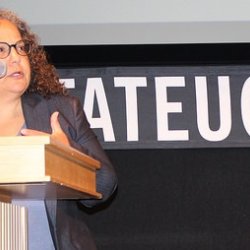Last month, GRID Alternatives Greater Los Angeles unveiled the Los Angeles Energy & Equity Policy Series (LEEPS) with our first symposium on multifamily solar. Here in a series of blog posts, we're excited to share three important takeaways from our rich conversation on maximizing the benefits of solar to affordable housing tenants and the organizations that operate such housing. Revisit the older posts in this series here or here. Our study with UCLA's Luskin Center for Innovation provides more data on multifamily solar potential in Los Angeles.
Takeaway #3 from LEEPS: Without virtual net metering for over 1.6 million multifamily customers in the City of Los Angeles, a significant barrier to energy equity remains in place.
Background: GRID Alternatives Greater Los Angeles was proud to host some of the City of Los Angeles’ most prominent policy makers, including keynotes from Lauren Faber (Chief Sustainability Officer, City of Los Angeles) and Nancy Sutley (Los Angeles Department of Water and Power). Speakers and attendees took note of how much potential there is in the City of Los Angeles to encourage energy equity through the development of solar on affordable housing (specifically: 43 MW of rebate-eligible rooftop solar potential on the City’s affordable housing). Solar on affordable housing aligns perfectly with recent commitments from the City of Los Angeles and the Los Angeles Department of Water and Power to prioritize equity in a rapidly changing energy landscape.
Yet, for both public institutions, there remains a disconnect between intention and ability to follow through on the commitment, as current utility policy stands in direct conflict with energy equity. More specifically, LADWP – the largest municipal utility in the country – does not provide virtual net energy metering (VNEM) or a mechanism for the more than 1.4 million LADWP multifamily customers (46% of customer base) to access solar.
Key Ideas:
The absence of virtual net metering creates two adverse policy outcomes for the City of Los Angeles:
- Environmental inequity, exacerbated by the ease at which upper-income homeowners can install solar and experience financial savings. Conversely, lower-income renters find it nearly impossible to access solar and its savings. Nearly half of LADWP customers live in multifamily settings, including renters who earn less than half of homeowner median income. In other words, while homeowners in Bel-Air might be able to utilize rebates to install solar on their property with relative ease, renters in South Los Angeles cannot access solar and solar rebates because the absence of VNEM tariffs does not allow new savings to be reflected in their utility bills.
- Potential external investment loss, and the disqualification from higher solar at affordable housing rebates due to the inability to deliver direct financial benefits to affordable housing residents. For example, the Low-Income Weatherization program offers a maximum rebate of $3.50 per watt for the portion of a solar system that delivers financial benefits to affordable housing residents. Without a mechanism to deliver these benefits, the maximum rebate LADWP customers can qualify for is $1.50. Thus, the City of Los Angeles and its municipal utility are forgoing up to $116.7 million in potential state solar investment. Costs that could be eliminated through rebates are unnecessarily passed on to taxpayers and ratepayers.
Speakers and attendees agree that LADWP must prioritize the implementation of virtual net metering to expand solar equity and to maximize state investment for affordable housing property owners.

